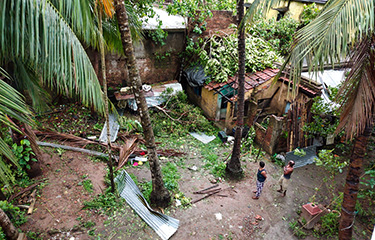Cyclone Amphan has caused widespread destruction to two states in eastern India and neighboring Bangladesh, at a time when both countries are struggling with the COVID-19 outbreak.
The cyclone made landfall in West Bengal, India, on 20 May with high wind speeds. It then traveled across India before hitting Bangladesh, The Hindu reported Thursday, 21 May, citing an update from India’s Ministry of Earth Sciences.
Fishermen have been warned not to venture into the sea during the storm. Earlier in the week, fishing trawlers and boats in the region were told to return to shore for safety ahead of the Amphan’s landfall.
As of 21 May, road clearance and restoration efforts in West Bengal were already underway. The cyclone killed an estimated 72 people in West Bengal, and hit Kolkata and other locations in the state – with trees being uprooted, thousands of houses ravaged, and lower areas damaged, the Business Standard reported 21 May.
While the final amount of the damage is not yet known, West Bengal Chief Minister Mamata Banerjee estimated that the cyclone could have caused up to INR 1 trillion (USD 13.3 billion, EUR 12 billion) worth of damage in the region. While it will take two to three days to assess the damages, she said the cyclone hit her state even worse than the COVID-19 pandemic.
“There is huge loss in agriculture. We will first provide humanitarian help like food, water and shelter to those affected. Then we will think of a way to financially help or provide job avenues, so that they can stand on their feet,” Banerjee told The Indian Express.
The coastal state of Odisha is also in the process of calculating possible damages caused by the calamity. As the state is not in the eye of the cyclone as in West Bengal, the “damage has not been too bad,” an official told the Indian Express.
The Reporters Today reported Thursday that a number of fishing boats and fishing nets in the Sandhkuda and Nehru Bangla areas in Odisha have been damaged by the cyclone, along with losses from crops.
An executive from a seafood company based in Andhra Pradesh, further south of West Bengal, told SeafoodSource on 21 May that the Amphan was likely to leave a trail of destruction behind for the affected regions.
“There is some shrimp farming in the region (Sundarbans) where the cyclone made the landfall. It probably accounts for about 7 percent of total India shrimp production. It's extensive farming with low stocking densities,” he said, adding that the actual damages to shrimp farms are yet to be known.
Sundarbans is a mangrove forest area that lies on the delta of the Ganges, Brahmaputra, and Meghna rivers on the Bay of Bengal.
In Bangladesh, at least 12 people were killed as the cyclone ravaged the country’s coastal areas. Hundreds of houses and fish enclosures in Khulna District in the Division of Khulna have been broken down during the severe storm, the United News of Bangladesh reported 21 May.
The Amphan cyclone is adding more pressure to India and Bangladesh in the efforts to contain the spread of the coronavirus. As hundreds of thousands of people have been evacuated to shelters, and will live there for days, risks of infection are high, the Financial Express reported on 21 May.
As of 21 May, India had 112,359 confirmed cases of the coronavirus, with 3,435 deaths, while the similar numbers in Bangladesh were 28,511 and 408, respectively, according to media reports from the two countries.
Photo courtesy of Boby Ortain/Shutterstock







